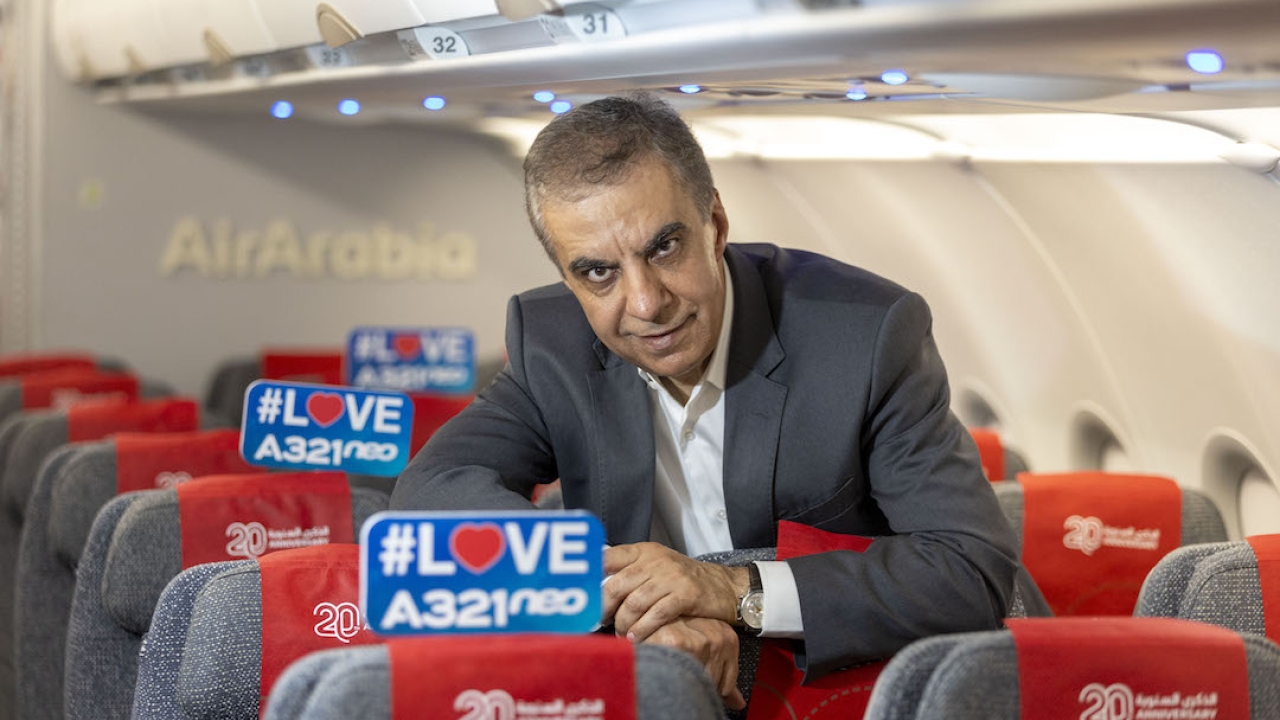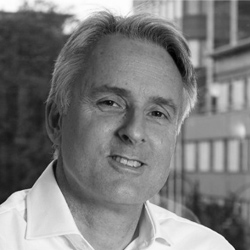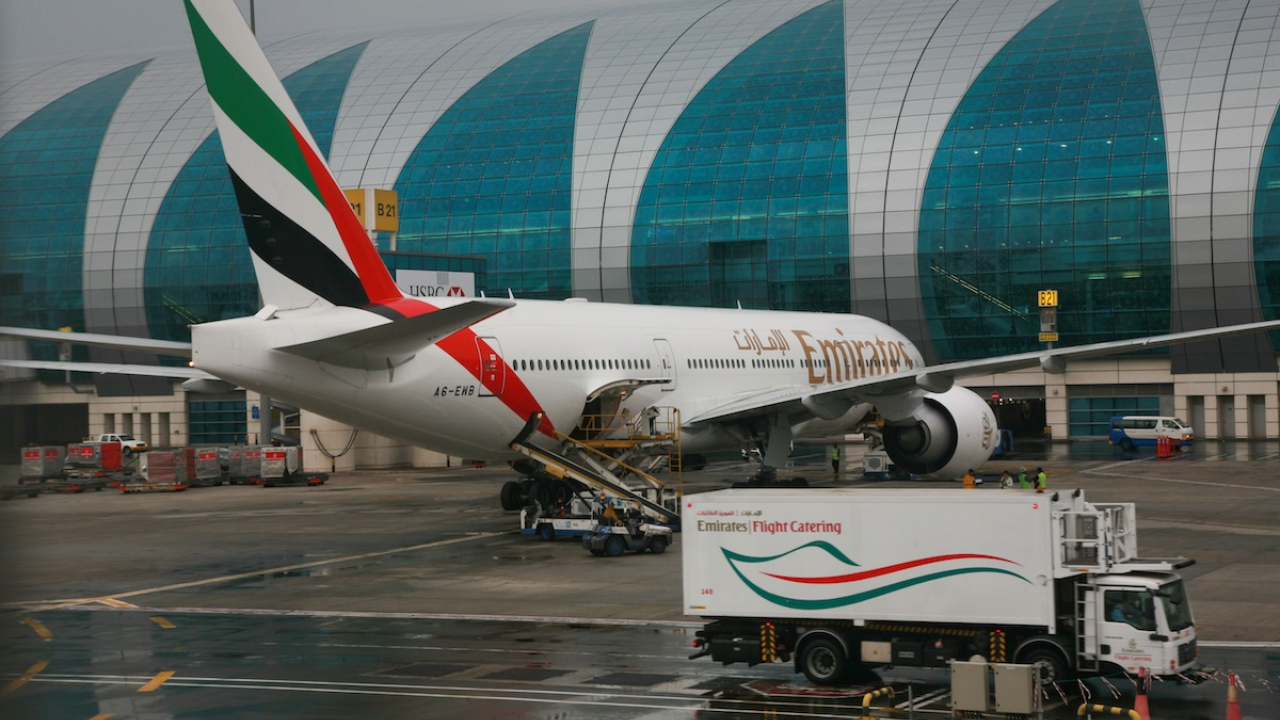Air Arabia Sharjahs ahead
Air Arabia’s consistent growth story is continuing as it builds up its main Sharjah hub, expands at its other bases, and increases its fleet.

Air Arabia and its CEO Adel Ali showed off one of its Airbus A321LR single-aisle aircraft at the Dubai Airshow. PICTURE: Billypix
Adel Ali may have just put pen to paper on one of his airline’s largest ever deals, committing to 240 CFM International Leap-1A engines to power its existing order for 120 Airbus A320neo family aircraft, but the chief executive of Air Arabia is calmness personified.
The interview with Arabian Aerospace took place in the gleaming 215-seat cabin of Air Arabia’s latest A321neo, a cool sanctuary away from the crowds and heat of the flightline during November’s Dubai Airshow.
The new A320neos, consisting of 73 A320neos, 27 A321neos and 20 A321XLRs, will begin arriving in the second half of 2025, explained Ali. They will take Air Arabia’s fleet total well beyond 100 aircraft. At the end of 2023 it was operating 71 A320s and A321s.
The new aircraft’s fuselage was sporting a special emblem celebrating the airline’s two decades of existence. The carrier first took to the air in October 2003 with an A320 service from its Sharjah International Airport base to Bahrain.
Its new A320neos will be delivered at a pace perfectly in tune with Air Arabia’s steady, but deliberately unspectacular strategy with a focus on profitable growth. For instance, over its 20-year history the Middle East’s first ever low-cost carrier has only averaged adding just three-to-four aircraft a year to its fleet.
Over the years, it has branched out from its Sharjah roots, but this city, with a population of about two million is the third largest in the UAE after Abu Dhabi and Dubai and “still represents more than 60 per cent of our overall operation,” said Ali.
In the UAE market, Air Arabia is happy with its bases at Sharjah, Abu Dhabi, and Ras Al Khaimah, and it makes “no sense” to look at another UAE base.
“With those three I think it’s sufficient,” said Ali. “The distance of travelling is not far so there is no point. It you want to get anywhere to fly Air Arabia [in the UAE] it's probably a 45-minute drive, maximum, between these airports.”
And Sharjah has a role as Air Arabia adds bases. “It has the infrastructure to support all our other hubs,” said Ali. “We built it over the last 20 years [with that in mind] so that it becomes much more user-friendly and with technology to support every hub that we have.”
In its first year of operation Air Arabia transported 200,000 people through Sharjah, a number that mushroomed to 10 million a year by the end of 2023, said Ali. And there is room for more growth, a fact recognised by HH Sheikh Dr Sultan bin Mohammed Al Qasimi, supreme council member and ruler of Sharjah, who approved a project to expand Sharjah’s congested airport in June 2023.
According to Ali, this capacity is needed with Sharjah’s capacity being increased to 22 million by 2025-26. The airport has a design capacity of eight million passengers.
In 2024, Air Arabia will take seven Airbus 320s to bolster its 45-aircraft strong Sharjah operation, said Ali. Outside of the UAE, its second base to be launched was in Morocco, where it bases nine A320s, topped up with another four-five units in the peak summer months. “In 2024 we are going to put at least three additional aeroplanes there,” said Ali.
Its Egypt base has four aircraft. “The plan is now that [Egypt’s] currency model is stable we hope to put more aircraft in Egypt in 2024 as well,” he added. All its other bases, such as Abu Dhabi, Ras Al Khaimah, and in Pakistan, will receive more A320s in 2024, with only its operation in Armenia staying static at two aircraft until the political situation there is clearer.
Ali views the air transport transformation under way in Saudi Arabia as extremely positive and there could be an opportunity to establish an airline there, but not now.
“At the moment, with all the airlines that they are announcing and putting in place, for us it is good to fly to and from Saudi, but we don't feel there is a route to go and set up a hub,” explained Ali. “I think what is important is that we don't rush in too many places. And not every opportunity that comes along do you want to pick up because then you lose focus. It is important to really wait and see what is worth doing.”
Stay up to date
Subscribe to the free Times Aerospace newsletter and receive the latest content every week. We'll never share your email address.


